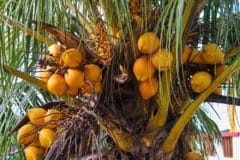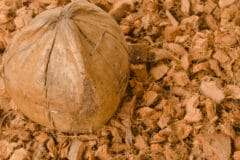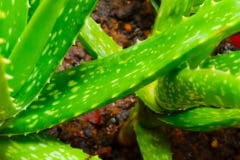General Information
Coconut (Cocos nucifera) palms are hardy growing in USDA zones 10 and 11, as well as the warmest areas of zone 9b. However, they will not survive in prolonged freezing temperatures, so those living in zone 9 might lose their tree if an unexpected freeze hits their area. To give the tree an added layer of protection during cold weather, thoroughly water the soil around the tree the day before, as the water insulates the tree’s roots and keeps them warm.
The palm has a smooth, single trunk that grows upright or slightly curved, depending on the cultivar, and obtains a height of about 60 feet at maturity. Once the tree reaches around six years of age it starts blooming, generally in spring. The flowers slowly develop into coconuts, which take around a year to become ripe.
Preferred Soil Conditions
Coconut palms tolerate a wide range of soil types, including those that are salty or brackish. However, if you intend to plant the palm in a low-lying area of your landscape that is prone to wetness, create a raised bed to lift the roots out of the constantly soggy conditions. To create the bed, pile the native soil up so it’s several feet high and wide, before planting the coconut palm.
In normal soil conditions, there’s no need to add amendments into the planting site before planting the tree and it’s best to plant directly in the native soil. The tree tolerates the following soil conditions:
- Well-drained sandy, loamy or clayey soils.
- Acidic or alkaline soils.
- Soils with a pH of 5.0 to 8.0.
- Tolerates soil that floods periodically.
Dealing with Hardpan Soils
If you are planting the coconut palm in an area where there’s hardpan, you may need to break the hardpan up and incorporate some topsoil into the mixture before planting the coconut palm.
Planting & Aftercare Considerations
If you plan to add a coconut palm to your landscape, select an appropriate site and consider the tree’s aftercare.
- Select a location where falling coconuts won’t damage cars, structures or people, especially if you live where hurricanes frequent the area.
- Consider the tree’s mature size, when selecting a site.
- Coconut palms perform best grown in a sunny location.
- Plant the coconut palm at the same depth it was growing in its nursery container.
- Although drought-tolerant once established, water newly planted trees weekly up to the first year, while the roots establish themselves into the site.
- Applying several inches of mulch around the planting site reduces weeds and helps the soil retain moisture.
Appropriate Feeding
To prevent nutritional deficiencies in coconut palms, a regular schedule of feeding is needed. Use a “palm special” blend and spread evenly over the soil underneath the canopy at a rate of 1.5 pounds per 100 square feet. Rake into the area and water in well after applying. Don’t let the fertilizer butt against the trunk or burning can occur. Fertilize three times yearly or every four months.












